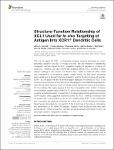Structure-Function Relationship of XCL1 Used for in vivo Targeting of Antigen Into XCR1+ Dendritic Cells
Kroczek, Arthur L.
Hartung, Evelyn
Gurka, Stephanie
Becker, Martina
Reeg, Nele
Mages, Hans Werner
Voigt, Sebastian
Freund, Christian
Kroczek, Richard
XCL1 is the ligand for XCR1, a chemokine receptor uniquely expressed on crosspresenting
dendritic cells (DC) in mouse and man. We are interested in establishing
therapeutic vaccines based on XCL1-mediated targeting of peptides or proteins into
these DC. Therefore, we have functionally analyzed various XCL1 domains in highly
relevant settings in vitro and in vivo. Murine XCL1 fused to ovalbumin (XCL1-OVA)
was compared to an N-terminal deletion variant lacking the first seven N-terminal
amino acids and to several C-terminal (deletion) variants. Binding studies with primary
XCR1+ DC revealed that the N-terminal region stabilizes the binding of XCL1 to its
receptor, as is known for other chemokines. Deviating from the established paradigm for
chemokines, the N-terminus does not contain critical elements for inducing chemotaxis.
On the contrary, this region appears to limit the chemotactic action of XCL1 at higher
concentrations. A participation of the XCL1 C-terminus in receptor binding or chemotaxis
could be excluded in a series of experiments. Binding studies with apoptotic and necrotic
XCR1-negative cells suggested a second function for XCL1: marking of stressed cells
for uptake into cross-presenting DC. In vivo studies using CD8+ T cell proliferation
and cytotoxicity as readouts confirmed the critical role of the N-terminus for antigen
targeting, and excluded any involvement of the C-terminus in the uptake, processing,
and presentation of the fused OVA antigen. Together, these studies provide basic data
on the function of the various XCL1 domains as well as relevant information on XCL1 as
an antigen carrier in therapeutic vaccines.
Dateien zu dieser Publikation

